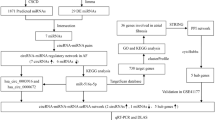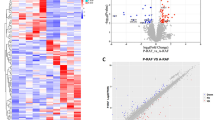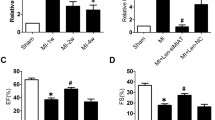Abstract
Purpose
Dysregulation of long non-coding RNAs (lncRNAs) and microRNAs (miRNAs) plays important roles in atrial fibrillation (AF). This study aimed to identify crucial lncRNAs, miRNAs, and mRNAs in AF based on whole transcriptome sequencing.
Methods
Thirty Sprague Dawley rats were randomly stratified into control and chronic intermittent hypoxia (CIH) groups (n = 15 in each). Hematoxylin-eosin staining, Masson staining, immunohistochemical assay, and western blotting were used to evaluate this model. Thereafter, atrial tissues were sent for whole transcriptome sequencing. Finally, fibrosis-related competing endogenous RNA (ceRNA) regulatory networks were built, and the relative levels of lncRNAs, miRNAs, and mRNAs were validated by real-time quantitative polymerase chain reaction (RT-qPCR) or western blotting.
Results
A CIH-induced atrial fibrosis rat model was successfully constructed. After sequencing, 268 differentially expressed lncRNAs (DELs), 20 differentially expressed miRNAs (DEMs), and 436 differentially expressed genes (DEGs) were identified. Functional analyses showed that these DEGs were associated with several processes and pathways, including “cell division,” “IL-17 signaling pathway,” “NOD-like receptor signaling pathway,” and “cell adhesion molecules.” Fibrosis-related ceRNA networks were then built, comprising five lncRNAs, seven miRNAs, and 19 DEGs. RT-qPCR and western blotting results showed that the patterns of lncRNAs (NONRATT016396.2, NONRATT001596.2, NONRATT011456.2), miRNAs (miR-10b-3p, miR-29b-3p), and mRNAs (Gng7 and Wnt2b) were consistent with sequencing analyses.
Conclusions
The DELs, DEMs, and DEGs identified in this study may participate in atrial fibrosis processes, and the occurrence and progression of AF.







Similar content being viewed by others
Data availability
I confirm I have included a Data Availability Statement in my manuscript. BioProject: PRJNA786466
Abbreviations
- AF:
-
atrial fibrillation
- CIH:
-
chronic intermittent hypoxia
- lncRNAs:
-
long non-coding RNAs
- miRNAs:
-
microRNAs
- ceRNA:
-
competing endogenous RNAs
- GO:
-
Gene Ontology
- KEGG:
-
Kyoto Encyclopedia of Genes and Genomes
- log2 FC:
-
log2 fold change
References
Ponamgi SP, Siontis KC, Rushlow DR, Graff-Radford J, Montori V, Noseworthy PA. Screening and management of atrial fibrillation in primary care. Bmj. 2021;373:n379
Chugh SS, Havmoeller R, Narayanan K, Singh D, Rienstra M, Benjamin EJ, et al. Worldwide epidemiology of atrial fibrillation: a Global Burden of Disease 2010 study. Circulation. 2014;129(8):837–47.
Anumonwo JM, Kalifa J. Risk factors and genetics of atrial fibrillation. Heart Fail Clin. 2016;12(2):157–66.
Nguyen TN, Hilmer SN, Cumming RG. Review of epidemiology and management of atrial fibrillation in developing countries. Int J Cardiol. 2013;167(6):2412–20.
Huang HD, Darbar D. Genetic risk scores for atrial fibrillation: do they improve risk estimation? Can J Cardiol. 33(4):422–424. https://doi.org/10.1016/j.cjca.2016.12.006
Nattel S, Burstein B, Dobrev D. Atrial remodeling and atrial fibrillation: mechanisms and implications. Circ Arrhythm Electrophysiol. 2008;1(1):62–73.
Kim D, Yang PS, You SC, Sung JH, Jang E, Yu HT, et al. Treatment timing and the effects of rhythm control strategy in patients with atrial fibrillation: nationwide cohort study. Bmj. 2021;373:n991.
Babapoor-Farrokhran S, Gill D, Rasekhi RT. The role of long noncoding RNAs in atrial fibrillation. Heart Rhythm. 2020;17(6):1043–9.
Franco D, Aranega A, Dominguez JN. Non-coding RNAs and atrial fibrillation. Adv Exp Med Biol. 2020;1229:311–25.
Zhao L, Ma Z, Guo Z, Zheng M, Li K, Yang X. Analysis of long non-coding RNA and mRNA profiles in epicardial adipose tissue of patients with atrial fibrillation. Biomed Pharmacother. 2020;121(109634):12.
Du J, Li Z, Wang X, Li J, Liu D, Wei J, et al. Long noncoding RNA TCONS-00106987 promotes atrial electrical remodelling during atrial fibrillation by sponging miR-26 to regulate KCNJ2. J Cell Mol Med. 2020;24(21):12777–88.
Cao F, Li Z, Ding WM, Yan L, Zhao QY. LncRNA PVT1 regulates atrial fibrosis via miR-128-3p-SP1-TGF-β1-Smad axis in atrial fibrillation. Mol Med. 2019;25(1):019–0074.
Wang W, Zhang K, Li X, Ma Z, Zhang Y, Yuan M, et al. Doxycycline attenuates chronic intermittent hypoxia-induced atrial fibrosis in rats. Cardiovasc Ther. 2018;36(3):e12321. https://doi.org/10.1111/1755-5922.12321.
Ma Z, Zhang K, Wang Y, Wang W, Yang Y, Liang X, et al. Doxycycline improves fibrosis-induced abnormalities in atrial conduction and vulnerability to atrial fibrillation in chronic intermittent hypoxia rats. Med Sci Monit. 2020;26:e918883. https://doi.org/10.12659/MSM.918883.
Bolger AM, Lohse M, Usadel B. Trimmomatic: a flexible trimmer for Illumina sequence data. Bioinformatics. 2014;30(15):2114–20.
Ritchie ME, Phipson B, Wu D, Hu Y, Law CW, Shi W, et al. limma powers differential expression analyses for RNA-sequencing and microarray studies. Nucleic Acids Res. 2015;43(7):20.
Lewis BP, Burge CB, Bartel DP. Conserved seed pairing, often flanked by adenosines, indicates that thousands of human genes are microRNA targets. Cell. 2005;120(1):15–20. https://doi.org/10.1016/j.cell.2004.12.035.
John B, Enright AJ, Aravin A, Tuschl T, Sander C, Marks DS. Human MicroRNA targets. Plos Biol. 2004;2(11):e363.
Otasek D, Morris JH, Bouças J, Pico AR, Demchak B. Cytoscape automation: empowering workflow-based network analysis. Genome Biol. 2019;20(1):019–1758.
Heijman J, Algalarrondo V, Voigt N, Melka J, Wehrens XH, Dobrev D, et al. The value of basic research insights into atrial fibrillation mechanisms as a guide to therapeutic innovation: a critical analysis. Cardiovasc Res. 2016;109(4):467–79. https://doi.org/10.1093/cvr/cvv275.
Sohns C, Marrouche NF. Atrial fibrillation and cardiac fibrosis. Eur Heart J. 2020;41(10):1123–31. https://doi.org/10.1093/eurheartj/ehz786.
Nattel S. Molecular and cellular mechanisms of atrial fibrosis in atrial fibrillation. JACC Clin Electrophysiol. 2017;3(5):425–35. https://doi.org/10.1016/j.jacep.2017.03.002.
Wulandari E, Jusman SW, Moenadjat Y, Jusuf AA, Sadikin M. Expressions of Collagen I and III in hypoxic keloid tissue. Kobe J Med Sci. 2016;62(3):E58-69.
Grosman-Rimon L, Billia F, Wright E, Carasso S, Elbaz-Greener G, Kachel E, et al. Neurohormones, inflammatory mediators, and cardiovascular injury in the setting of heart failure. Heart Fail Rev. 2020;25(5):685–701.
Kim KK, Sheppard D, Chapman HA. TGF-β1 signaling and tissue fibrosis. Cold Spring Harbor Perspect Biol. 2018;10(4):a022293. https://doi.org/10.1101/cshperspect.a022293.
Lv W, Booz GW, Fan F, Wang Y, Roman RJ. Oxidative stress and renal fibrosis: recent insights for the development of novel therapeutic strategies. Front Physiol. 2018;9:105. https://doi.org/10.3389/fphys.2018.00105.
Gal P, Marrouche NF. Magnetic resonance imaging of atrial fibrosis: redefining atrial fibrillation to a syndrome. Eur Heart J. 2017;38(1):14–9. https://doi.org/10.1093/eurheartj/ehv514.
Tian XP, Wang CY, Jin XH, Li M, Wang FW, Huang WJ, et al. Acidic microenvironment up-regulates exosomal miR-21 and miR-10b in early-stage hepatocellular carcinoma to promote cancer cell proliferation and metastasis. Theranostics. 2019;9(7):1965–79.
Jin L, Zhang J, Fu HQ, Zhang X, Pan YL. FOXO3a inhibits the EMT and metastasis of breast cancer by regulating TWIST-1 mediated miR-10b/CADM2 axis. Transl Oncol. 2021;14(7):101096.
Wang D, Wang Z, Zhang L, Sun S. LncRNA PDCD4-AS1 alleviates triple negative breast cancer by increasing expression of IQGAP2 via miR-10b-5p. Transl Oncol. 2021;14(1):25.
Galluzzo A, Gallo S, Pardini B, Birolo G, Fariselli P, Boretto P, et al. Identification of novel circulating microRNAs in advanced heart failure by next-generation sequencing. ESC Heart Fail. 2021;2(10):13371.
Li H, Pan Z, Chen Q, Yang Z, Zhang D. SMILR aggravates the progression of atherosclerosis by sponging miR-10b-3p to regulate KLF5 expression. Inflammation. 2020;43(5):1620–33.
Xie Y, Wang Q, Gao N, Wu F, Lan F, Zhang F, et al. MircroRNA-10b promotes human embryonic stem cell-derived cardiomyocyte proliferation via novel target gene LATS1. Mol Ther Nucleic Acids. 2020;19:437–45.
Yan Y, Shi R, Yu X, Sun C, Zang W, Tian H. Identification of atrial fibrillation-associated microRNAs in left and right atria of rheumatic mitral valve disease patients. Genes Genet Syst. 2019;94(1):23–34.
Fang L, Ellims AH, Moore XL, White DA, Taylor AJ, Chin-Dusting J, et al. Circulating microRNAs as biomarkers for diffuse myocardial fibrosis in patients with hypertrophic cardiomyopathy. J Transl Med. 2015;13(314):015–0672.
Yang Q, Cui J, Wang P, Du X, Wang W, Zhang T, et al. Changes in interconnected pathways implicating microRNAs are associated with the activity of apocynin in attenuating myocardial fibrogenesis. Eur J Pharmacol. 2016;784:22–32.
Steimle JD, Rankin SA, Slagle CE, Bekeny J, Rydeen AB, Chan SS, et al. Evolutionarily conserved Tbx5-Wnt2/2b pathway orchestrates cardiopulmonary development. Proc Natl Acad Sci U S A. 2018;115(45):E10615–24.
Xie H, Miao N, Xu D, Zhou Z, Ni J, Yin F, et al. FoxM1 promotes Wnt/β-catenin pathway activation and renal fibrosis via transcriptionally regulating multi-Wnts expressions. J Cell Mol Med. 2021;25(4):1958–71.
Mizutani M, Wu JC, Nusse R. Fibrosis of the neonatal mouse heart after cryoinjury is accompanied by Wnt signaling activation and epicardial-to-mesenchymal transition. J Am Heart Assoc. 2016;5(3):002457.
Pfister O, Lorenz V, Oikonomopoulos A, Xu L, Häuselmann SP, Mbah C, et al. FLT3 activation improves post-myocardial infarction remodeling involving a cytoprotective effect on cardiomyocytes. J Am Coll Cardiol. 2014;63(10):1011–9.
Ma W, Liang F, Zhan H, Jiang X, Gao C, Zhang X, et al. Activated FMS-like tyrosine kinase 3 ameliorates angiotensin II-induced cardiac remodelling. Acta Physiol. 2020;230(2):18.
Zheng H, Tian H, Yu X, Ren P, Yang Q. G protein gamma 7 suppresses progression of lung adenocarcinoma by inhibiting E2F transcription factor 1. Int J Biol Macromol. 2021;182:858–65.
Ji W, Diao YL, Qiu YR, Ge J, Cao XC, Yu Y. LINC00665 promotes breast cancer progression through regulation of the miR-379-5p/LIN28B axis. Cell Death Dis. 2020;11(1):019–2213.
Hu CY, Chen J, Qin XH, You P, Ma J, Zhang J, et al. Long non-coding RNA NORAD promotes the prostate cancer cell extracellular vesicle release via microRNA-541-3p-regulated PKM2 to induce bone metastasis of prostate cancer. J Exp Clin Cancer Res. 2021;40(1):021–01891.
Dai H, Ji X, Huang X, Li W, Shi Z. MiR-379 relieves myocardial injury after acute myocardial infarction by regulating tumor necrosis factor-α-induced protein 8. Panminerva Med. 2020;14(10):03929–4.
Hsieh C-S, Huang P-S, Chang S-N, Wu C-K, Hwang J-J, Chuang EY, et al. Genome-wide copy number variation association study of atrial fibrillation related thromboembolic stroke. J Clin Med. 2019;8(3):332. https://doi.org/10.3390/jcm8030332.
Funding
This work was supported by the National Natural Science Foundation of China Youth Science Foundation Project (No. 81700304, No. 82000313), Tianjin Natural Science Foundation (No. 16KPXMSF00140, No. 18JCYBJC92200), The Scientific Research Fund Project of Key Laboratory of Second Hospital of Tianjin Medical University (No. 2019ZDSYS02, No. 2019ZDSYS07, No. 2019ZDSYS10, No. 2019ZDSYS11), The Research Fund for Central Laboratory of Second Hospital of Tianjin Medical University (No. 2020YDEY05), The Science & Technology Development Fund of Tianjin Education Commission for Higher Education (No. 2020KJ168), and The PhD Research Foundation of Affiliated Hospital of Jining Medical University (No. 2021-BS-005).
Author information
Authors and Affiliations
Corresponding authors
Ethics declarations
Ethics approval and consent to participate
All animal studies were conducted in compliance with guidelines from the Animal Administration Committee of Tianjin Medical University (approval number: TMUaMEC2016012).
Competing interests
The authors declare no competing interests.
Additional information
Publisher's note
Springer Nature remains neutral with regard to jurisdictional claims in published maps and institutional affiliations.
Bo Zhao, Weiding Wang, and Yu Liu are co-first authors.
Supplementary Information
Below is the link to the electronic supplementary material.
Rights and permissions
About this article
Cite this article
Zhao, B., Wang, W., Liu, Y. et al. Establishment of a lncRNA-miRNA-mRNA network in a rat model of atrial fibrosis by whole transcriptome sequencing. J Interv Card Electrophysiol 63, 723–736 (2022). https://doi.org/10.1007/s10840-022-01120-4
Received:
Accepted:
Published:
Issue Date:
DOI: https://doi.org/10.1007/s10840-022-01120-4




